|
Tarragon – The French Estragon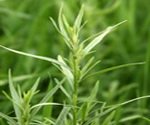
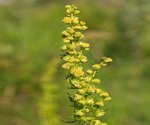
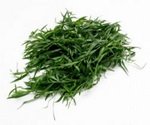
Tarragon is of the Asteracaea family also known as the daisy family, with botanical name Artemisia dracunculus also called French or true. The leaves are smooth, glossy, dark green long narrow leaves that shoot from opposite sides of wiry stalks. The plant has small yellowish buds that rarely develop into flowers. The French variety of the plant is loved by cooks because of its licorice-anise aroma.
There is a Spanish or Mexican variety of the plant which often is confused with the French variety. The Spanish form, known as the winter form of the herb actually bears bright yellow flowers, has sturdy, neat looking firm dark green leaves and a strong, spicy aroma similar to the French variety and is often sold to the unwary buyer as the French herb.
In addition, there is a Russian variety of the herb which grows taller and has paler, larger indented leaves with seed bearing flowers, but without the pungency or fragrance of the French variety. Origin The French herb is native to the Mediterranean and the Russian herb is native to Siberia.
History The earliest history of the herb tarragon is recorded by a 13th century Arab physician named Ibn Baithar, claimed that the herb was effective if chewed before taking medicine in dulling the unpleasant taste of medicine. The herb was introduced to England in 1548 and to the United States by 1806. The herb gets its name from the way its root system is coiled like a serpent ready to strike, thus the name estragon in French meaning little dragon and tarkhun in Arabic for dragon. Buying/Storage The French herb is not easy to purchase due to lack of availability, so buyers should be cautious, because if there is no obvious anise aroma and no tangy taste then it is probably the Russian herb, and the massive amounts of yellow flowers are an obvious sign that it isn’t the French variety since the French herb rarely blooms. The fresh herb will last for a few days in water. Dried tarragon is readily available and should have the anise aroma and tangy taste; the leaves should be dark green not dark brown. The dried herb should be stored in an airtight packet, shielded from light and extremes of heat and humidity. Use The French really love the herb and use it extensively in French cuisine, especially sauces such as Béarnaise. The herb also complements fish and shellfish, chicken, turkey, game, veal, and most egg dishes. The herb also goes well with vegetables such as asparagus, cauliflower, carrot, mushroom, and tomatoes.
For some great sections on herbs and spices some great references are: • The Spice and Herb Bible – Second Edition by Ian Hemphill with recipes by Kate Hemphill • The Food Encyclopedia by Jacques L. Rolland and Carol Sherman with other contributors • Field Guide to Herbs & Spices by Aliza Green • The Contemporary Encyclopedia of Herbs & Spices – Seasonings For The Global Kitchen by Tony Hill
Cooking Basics
|
Tarragon Botanical Cycle
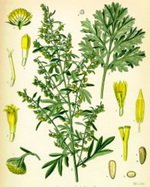
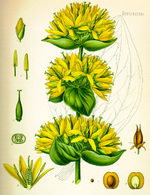
Daisy Family
Safflower
Tarragon





